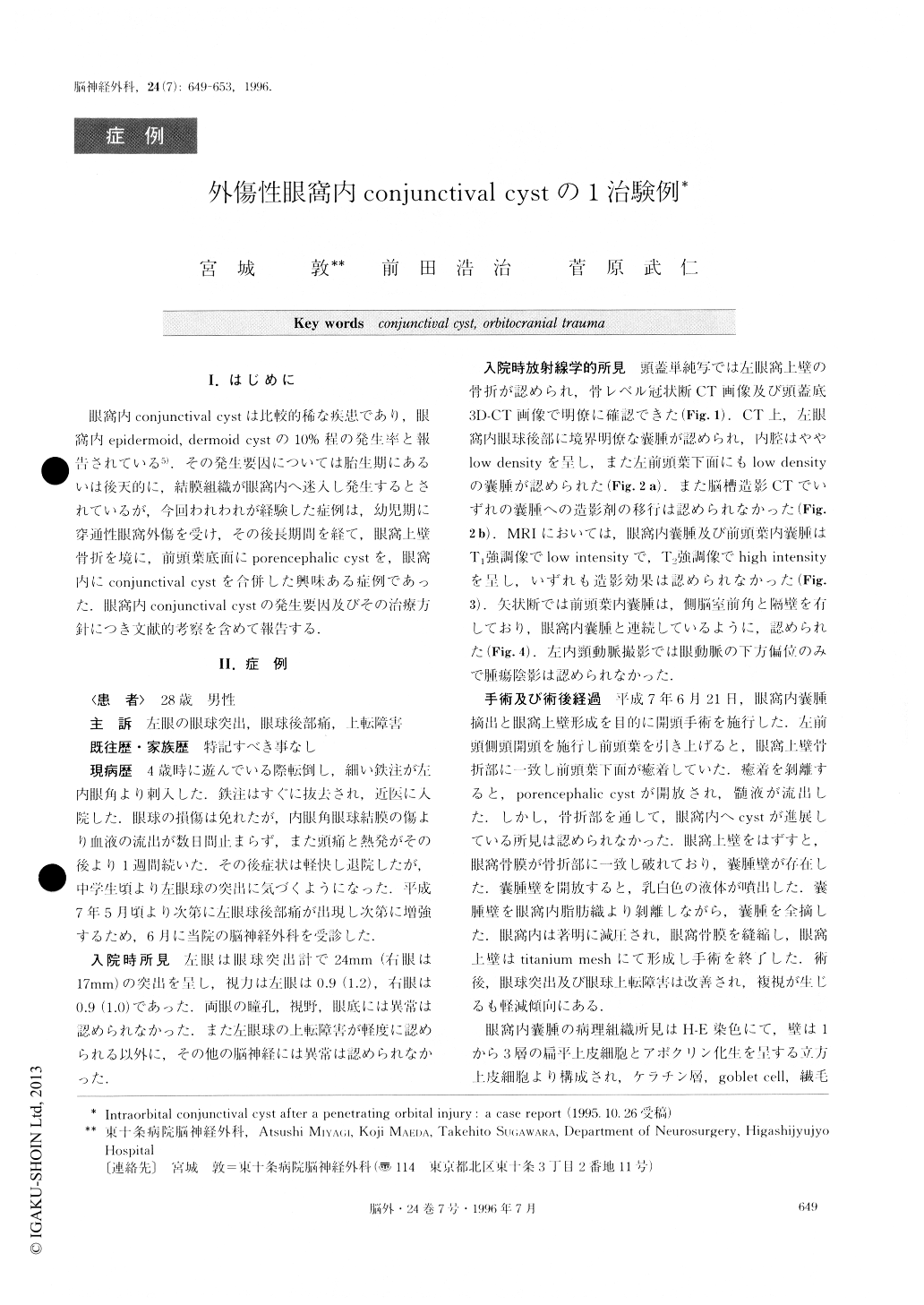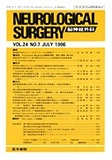Japanese
English
- 有料閲覧
- Abstract 文献概要
- 1ページ目 Look Inside
I.はじめに
眼窩内conjunctival cystは比較的稀な疾患であり,眼窩内epidermoid,dermoid cystの10%程の発生率と報告されている5).その発生要因については胎生期にあるいは後天的に,結膜組織が眼窩内へ迷入し発生するとされているが,今回われわれが経験した症例は,幼児期に穿通性眼窩外傷を受け,その後長期間を経て,眼窩上壁骨折を境に,前頭葉底面にporencephalic cystを,眼窩内にconjunctival cystを合併した興味ある症例であった.眼窩内conjunctival cystの発生要因及びその治療方針につき文献的考察を含めて報告する.
We report a case of intraorbital conjunctival cyst fol-lowing a penetrating orbitocranial injury. The patient was a 28-year-old male who was hospitalized with ex-ophthalmos, retrobulbar pain and upper gaze disturb-ance of his left eye. When he was 4 years old, a thin iron rod had penetrated intracranially through the inner angle of his left orbit. He was hospitalized and treated conservatively for about two weeks. The left eye ball was intact and visual acuity was normal, although bloody fluid had continuously flowed out from the left inner angle of the conjunctival wound for a few days.He had been febrile to 39℃ and complained of headache for one week. Subsequentry, the symptoms gradually improved through conservative therapy. When he was a junior high school student, he noticed exophthalmos of his left eye. However, he had never been examined closely, until he was 28 years old. We suspect that he had suffered from meningitis caused by the penetrating orbitocranial injury, and had fortunately improved under the conservative therapy. On admission to our hospital, a craniogram showed fracture of the left orbital roof, and coronal and three-dimensional computed tomography (CT) scans clearly demonstrated the orbital fracture. CT revealed a cystic mass in the retrobulbar space, and a porencephalic cyst in the me-dial basal frontal lobe. On magnetic resonance imaging (MRI) scans, both cysts were of low intensity on T1-weighted imaging, and of high intensity on T2-weighted images. Coronal and sagittal MRI scans showed that the two cysts were connected with each other through the fracture in the orbital roof. We dia-gnosed therefore that the orbital cyst was a herniated porencephalic cyst of the frontal lobe. Surgery was per-formed by a transcranial approach. The porencephalic cyst adhered to the fractured lesion of the fontal base but did not extend into the orbita. The intraorbital cyst was totally removed by opening the orbital roof includ-ing the fractured lesion. The cyst contained milky fluid. Postoperatively, the exophthalmos, retrobulbar pain and upper gaze disturbance showed gradual improve-ment. On histological examination, the cyst was found to be lined by non-keratinized stratified squamous epithelium and was diagnosed as a conjunctival cyst. This case was considered to be one of traumatic con-junctival cysts caused by a penetrating orbitocranial in-jury. Orbital conjunctival cysts have been reported to comprise about 10% of orbital epidermoid and dermoid cysts. Of these cysts, traumatic conjunctival cysts are rare, and only a few cases have been described. The etiology and therapy of orbital conjunctival cysts are discussed.

Copyright © 1996, Igaku-Shoin Ltd. All rights reserved.


